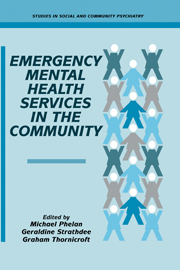Book contents
- Frontmatter
- Contents
- Contributors
- Foreword
- PRINCIPLES AND POLICIES
- CHALLENGE OF IMPLEMENTATION
- 9 Establishing a local emergency service
- 10 Maintaining an emergency service
- 11 Psychiatric emergencies in the casualty department
- 12 Acute crisis respite care
- 13 Family placement schemes as an alternative to short-term hospitalisation
- 14 Acute home-based care and community psychiatry
- 15 Acute day hospital care
- 16 Acute in-patient wards
- 17 The future of mental health emergency services
- Index
16 - Acute in-patient wards
from CHALLENGE OF IMPLEMENTATION
Published online by Cambridge University Press: 28 October 2009
- Frontmatter
- Contents
- Contributors
- Foreword
- PRINCIPLES AND POLICIES
- CHALLENGE OF IMPLEMENTATION
- 9 Establishing a local emergency service
- 10 Maintaining an emergency service
- 11 Psychiatric emergencies in the casualty department
- 12 Acute crisis respite care
- 13 Family placement schemes as an alternative to short-term hospitalisation
- 14 Acute home-based care and community psychiatry
- 15 Acute day hospital care
- 16 Acute in-patient wards
- 17 The future of mental health emergency services
- Index
Summary
This chapter will outline the general aims of in-patient admission within an emergency mental health service, and consider aspects of the in-patient management of some particular clinical problems or patient groups. Resources required for in-patient units will be reviewed. The chapter ends with a brief description of one innovative model of in-patient care.
Recent decades have seen a dramatic shift in the focus of psychiatric care from mental hospitals to the community. The overall psychiatric in-patient population has dropped markedly, but this is accounted for largely by the rehabilitation and resettlement in the community of long-stay in-patients. The number of psychiatric patients in hospital for less than one year has changed very little. Alternatives to hospitalisation have been developed, including intensive community (Burti and Tansella, chapter 14) or day hospital provision (Creed, chapter 15). While pilot studies have demonstrated that such innovative approaches are viable and may have numerous advantages, there are many practical reasons why they cannot be easily implemented more widely in Britain and in other countries. Similarly, the impetus for the development of community mental health resource centres and crisis intervention teams was to reduce the need for in-patient admissions. For crisis intervention, a recent World Health Organization report (Katschnig, chapter 1) has concluded that, while crisis intervention may reduce the duration of in-patient admissions, its impact on the number of admissions remains unproven.
- Type
- Chapter
- Information
- Emergency Mental Health Services in the Community , pp. 320 - 339Publisher: Cambridge University PressPrint publication year: 1995
- 2
- Cited by

